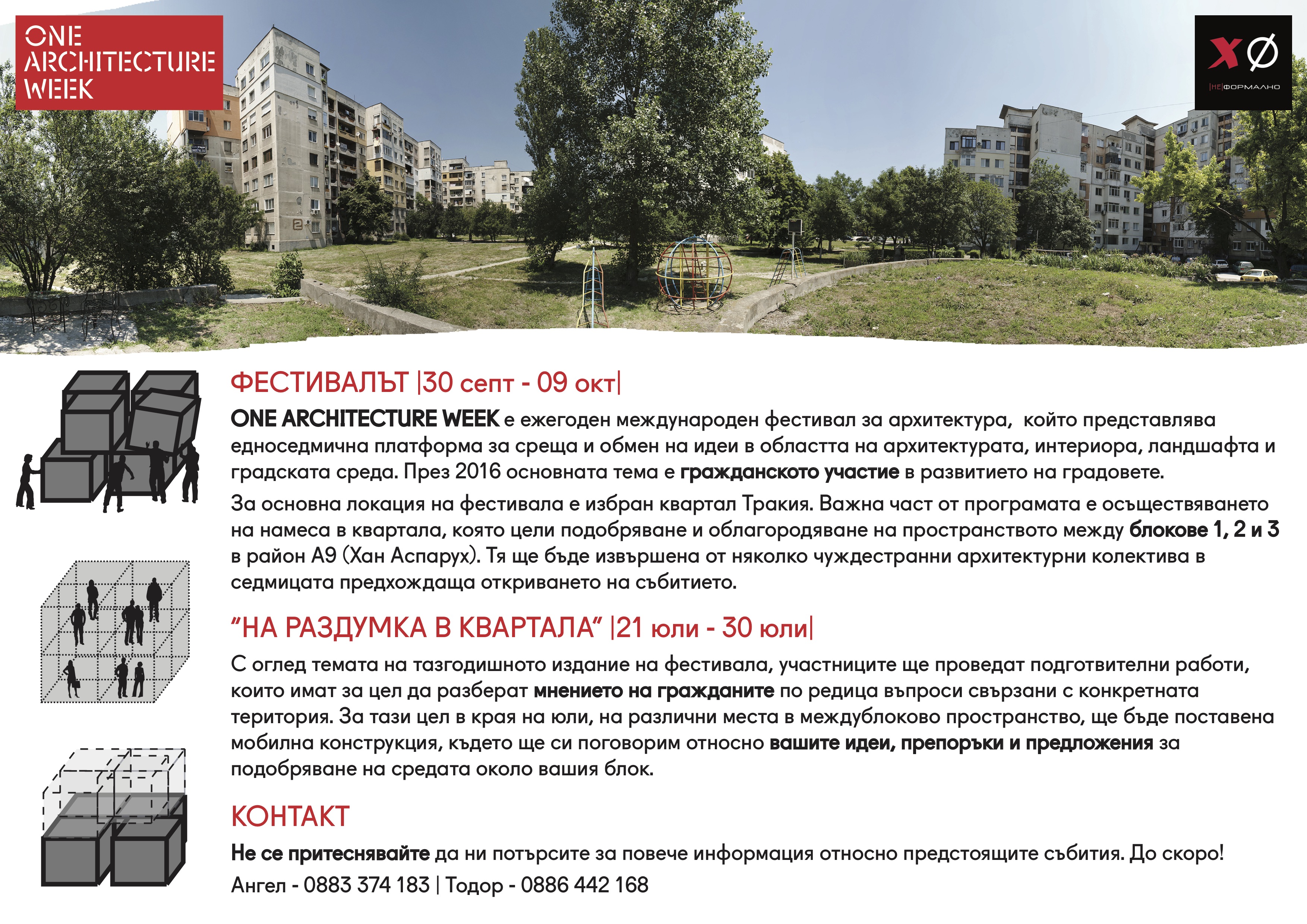
This year ONE ARCHITECTURE WEEK will have one main intervention. It will take place in the plattenbau district Trakiya and the citizens will play an important part in it.
Alongside the citizens, students and bulgarian and foreign architects will work on the intervention. The teams that are already working on it are:
From Bulgaria, |In|-Formal
From Austria, Gabu Heindl
From France, Gozangue Lacombe and Alexander Roemer
The intervention will take place in the open space between panel blocks 1, 2 and 3 in Trakiya. This is a place that combines all the typical elements of such structures: small-scale interventions made by the inhabitants, little shops in spaces on the ground floors of blocks, green spaces, adaptation of balconies, windows and facades, a power substation, remains of landscape design and more.
The process of preparation for the intervention is key. With a topic such as “Citizen participation” it’s more than important to include the inhabitants not only as users of the final product, but as creators as well. The idea of the festival is to use this process as an example of effective interaction between citizens, local administration and NGO’s. The bulgarian duo In-Formal, consisting of Todor Kesarov and Angel Bondov (both urban planners), has the task of attracting and involving inhabitants in the planning process and they tell us more about the progress of the intervention.
How do you try to involve the inhabitants?
According to us the best way to involve inhabitants is to break the process into different stages and create a bond of mutual trust with them. This way every time we meet they are less reserved and it is easier to have a dialogue and to gain the information about their needs and wants that we require.
What steps have you taken up until now?
We have had a couple of spontaneous meetings with the inhabitants of the three blocks. We have told them about this year’s Architecture week and our plans to involve the locals. We have put up some posters that contain all of this information as well.
How did people react?
Up until now people have been very positive, interested and willing to talk about this intervention. This was a result of our using of different psychological methods that depend on the position of the person – sitting, standing up or walking, and whether or not they are alone. Some were reserved at the beginning but most warmed up to us even in these few first encounters and have told us their opinion on the needed changes and the problem that they have – a type of information that we can not acquire elsewhere. We have heard stories about neighbours, the past and the history of each element we are researching and we have hope that the future meetings will be held with more people and enthusiasm from them to change this public space together with their neighbours and us.
What is next?
The most interesting and dynamic part of our task is yet to come. From the 21-st to the 28-th of June we will be building and moving a wooden structure in different locations between the blocks in order to be more “visible” and spark the local’s interest. We will be present not only physically, but also through different measures that help us understand the ideas, goals and wishes of the inhabitants that concern this space. Some of those tools are:
- ‘Window to the space’ – a real window through which people see an element and can draw something on it to illustrate how they see it change
- ‘Tag yourself’ – a model/map of the territory, on which people can mark positive and negative aspects and elements
- ‘Draw your neighbourhood’ – a children’s workshop where children draw the neighbourhood of their dream
- Formal and informal round tables and discussions
Do you work alongside with the municipality?
Yes, we work together with the local municipality of Trakiya. For us working with the local authorities is very important because we aspire to spread the methods we use and develop them in the future in different spaces in Trakiya. The Municipality has been very helpful to this moment. They allowed us to stay, mowed and cleaned the lawns and spaces, and requested for local experts, even the mayor, to be present at our meetings. A very good indicator of the Municipality’s work is the fact, that a lot of the citizens have met the mayor in person and have talked to him about similar to our topics. Namely this kind of citizen participation in the planning process is the goal of our intervention.
When will be the intervention executed and how will locals contribute to this process?
The intervention itself will be made in the week before the festival (23-29 September) by the aforementioned teams of architects and locals. In the future meetings we will be inquiring how the inhabitants are willing to help with the intervention – will they provide electricity, water, labour or something else entirely? This way the people will feel more involved in the intervention and that will decide whether or not it was successful and will be used in the future. Our biggest challenge is not to involve the citizens, but to try and change the model and mindset that things belong only to those who built them and not to the community.
Do you need any help?
The fact that we will be installing and deinstalling our construction each day means we will need more people. Help will be very welcome and we think this is a very interesting process, especially for urban planning, architecture, sociology, anthropology and psychology students, but anyone who has an interest in such a collaboration is welcome.You can contact us Angel(0883 374 183 / angelbondov@gmail.com) and Todor (0886 442 168 / tkesarovski@gmail.com) for more information and details.

